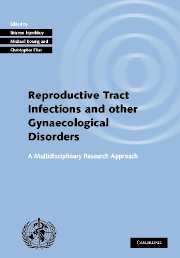 Investigating Reproductive Tract Infections and Other Gynaecological Disorders
Investigating Reproductive Tract Infections and Other Gynaecological Disorders Published online by Cambridge University Press: 07 December 2009
There are three main ways of measuring gynaecological morbidity: clinical examinations by trained medical practitioners, laboratory tests on biological specimens such as blood and urine, and questioning individuals or groups about their perceptions and experiences of illness. Clinical and laboratory approaches have been addressed in Chapters 8, 9 and 10. The central purpose of Chapters 11, 12 and 13 is to assess the role of the third approach to the measurement of gynaecological morbidity, its causes and consequences. The focus of this chapter is on structured interview surveys.
Interview surveys on health have been a familiar form of enquiry for decades. Many lessons have been learnt about their utility and limitations, and about measurement issues. Much of this experience is relevant to the design of surveys on gynaecological morbidity in low-income countries. Accordingly, this chapter starts with a summary of these lessons and the application of the survey method to two important dimensions of gynaecological morbidity – reproductive tract infections and menstrual dysfunction. These two morbidities have been chosen because they are the most prevalent gynaecological problems that women of reproductive age face, if not the most serious. As will become apparent, menstrual dysfunction lends itself well to investigation by the survey method and there is a growing body of experience upon which to draw. Conversely, the study of reproductive tract infections by surveys is relatively recent and has encountered serious problems
To save this book to your Kindle, first ensure [email protected] is added to your Approved Personal Document E-mail List under your Personal Document Settings on the Manage Your Content and Devices page of your Amazon account. Then enter the ‘name’ part of your Kindle email address below. Find out more about saving to your Kindle.
Note you can select to save to either the @free.kindle.com or @kindle.com variations. ‘@free.kindle.com’ emails are free but can only be saved to your device when it is connected to wi-fi. ‘@kindle.com’ emails can be delivered even when you are not connected to wi-fi, but note that service fees apply.
Find out more about the Kindle Personal Document Service.
To save content items to your account, please confirm that you agree to abide by our usage policies. If this is the first time you use this feature, you will be asked to authorise Cambridge Core to connect with your account. Find out more about saving content to Dropbox.
To save content items to your account, please confirm that you agree to abide by our usage policies. If this is the first time you use this feature, you will be asked to authorise Cambridge Core to connect with your account. Find out more about saving content to Google Drive.